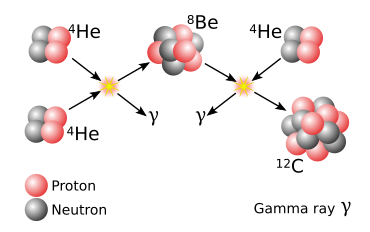Three alpha process
By the triple-alpha process ( 3α process ) be in the interior of stars three helium - nuclei ( α-particle ) by nuclear fusion reactions in carbon converted they emit gamma radiation from. This is also known as helium burning or, after its discoverer Edwin Salpeter , as the saltpeter process .
requirements
The three-alpha process can only take place at temperatures above 100 million Kelvin and requires the abundance of helium. Therefore, it normally only occurs in the centers of stars in the later phases of their development , when the pressure and temperatures are higher than currently in the sun and there is already enough helium through proton-proton reactions or the Bethe-Weizsäcker cycle ( CNO Cycle ). At the necessary temperatures, all the atomic nuclei involved are fully ionized , i.e. H. without electron shell .
The sun will only be entering the last phase of their life cycle in about 4 billion years ago, will be able to start the helium burning so-called ( "burning" helium) after in its core area of the whole hydrogen through the hydrogen burning into helium was merged. The increased radiation pressure during the helium burn leads to a puffing up of the outer layers of the sun, which now cool down because of the larger surface area, whereupon the radiation spectrum of the photosphere of the sun shifts to longer wavelengths . A star in this state is therefore called a red giant .
procedure
In detail, the 3α process takes place as follows:
- ( endothermic ; with the reverse reaction )
- ( exothermic )
The net amount of energy released during this process is 7.275 MeV . The carbon core 12 C can serve as a starting material for the carbon burning that may start later .
In the 3α process, the rate of energy release is proportional to the 30th power of the temperature. Thus, a 5% increase in temperature causes a 332% increase in energy release.
The beryllium nucleus 8 Be produced in the first step is unstable ( intermediate nucleus ) and disintegrates again into two helium nuclei 4 He with an average life of only 2.6 · 10 −16 s ; therefore, in order to produce a carbon nucleus, it is necessary that three α-particles collide almost simultaneously . This is very unlikely and therefore a noticeable amount of carbon is produced very slowly.
Practically no carbon could be produced as a result of the Big Bang , because the temperature fell too quickly below the temperature required for the fusion. This problem is also known as the beryllium barrier .
The low probability of the 3α process is mitigated by the fact that
- the ground state of 8 Be corresponds almost exactly to the energy of two α-particles.
- the energy of the two nuclei 8 Be and 4 He together corresponds almost exactly to the energy of a certain excited state of 12 C.
Both sub-steps of the process are therefore resonances with a correspondingly increased cross-section .
As the 3α process enabled the stars of the first generation after the Big Bang to produce large amounts of 12 C, this isotope is also known as the “primary” isotope of carbon.
Fred Hoyle saw an indication of the existence of a creative force in the dependence of the existence of carbon in the universe on the exact energy of an excited level of the carbon nucleus 12 C and the low probability of further fusion processes after the synthesis of oxygen . This special problem is, however, part of the overall complex of the not yet understood, actual or apparent fine-tuning of the natural constants .
Follow-up reactions
A consequence of the 3α process is that some of the carbon nuclei 12 C can fuse with other helium nuclei 4 He, producing the stable isotope 16 O of oxygen and releasing energy:
The next conversion step, in which oxygen 16 O would fuse with α-particles to produce neon 20 Ne, turns out to be unlikely due to nuclear spin rules. According to this, stellar nucleosynthesis produces large amounts of carbon and oxygen, but is largely prevented from converting these elements into neon and heavier elements.
Both oxygen and carbon thus form the "ashes" of the helium burning; At the end of this fusion phase, the core of the star essentially consists of these two elements.
See also
literature
- Bogdan Povh et al: Particles and Cores . 4th edition, Springer Verlag 1997, ISBN 3-540-61737-X , pp. 318-320
- Edwin Ernest Salpeter: Astrophys J 115 (1952), 326
Web links
- What is the beryllium barrier? from the alpha-Centauri television series(approx. 15 minutes). First broadcast on Apr 13, 2005.
Individual evidence
- ↑ Fred Hoyle: The Universe: Past and Present Reflections. In: Annual Reviews of Astronomy and Astrophysics 20 (1982), pp. 1-35.




